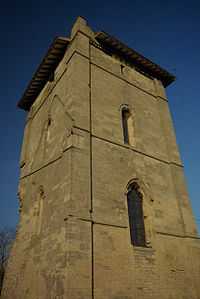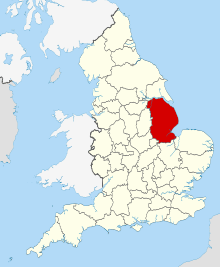Temple Bruer
| Temple Bruer | |
 Temple Bruer |
|
| OS grid reference | TF008537 |
|---|---|
| – London | 110 mi (180 km) S |
| District | North Kesteven |
| Shire county | Lincolnshire |
| Region | East Midlands |
| Country | England |
| Sovereign state | United Kingdom |
| Post town | LINCOLN |
| Postcode district | LN5 |
| Police | Lincolnshire |
| Fire | Lincolnshire |
| Ambulance | East Midlands |
| EU Parliament | East Midlands |
| UK Parliament | Sleaford and North Hykeham |
|
|
Coordinates: 53°04′16″N 0°29′46″W / 53.0711°N 0.4962°W
Temple Bruer is in a farm-yard in the civil parish of Temple Bruer with Temple High Grange, North Kesteven, Lincolnshire, England. It is one of the few Knights Templar sites left in England where any ruins remain standing. Its name comes from its Templar ownership and its position in the middle of the Lincoln Heath, bruyère (heather) from the French language current at the time. It was founded in the period 1150 to 1160 and the order was dissolved in 1312.[1][2]
It is at grid reference TF 0085 5370, located between the A15 and A607 roads, 2.5 miles (4.0 km) north from Cranwell. The site has been excavated twice, once in Victorian times and again at the start of the 20th Century.[1][2]
Rise and fall of the Knights Templar in Lincolnshire
The financing of wars, particularly in places as far away as the holy lands, was an expensive enterprise. The Templars financed their military campaigns through the income generated by their estates all over Europe, including several in Lincolnshire. Most of these served primarily as a means to generate income, but the Temple Bruer estate on the Lincoln Heath (a relatively featureless landscape largely free of trees) was different in that it was particularly suitable for use as a base for the practising of military manoeuvres. It thus became the centre of the Templars’ estates in Lincolnshire.

The Templars were suppressed at a time when England was on the brink of economic disaster. However, the great change in emphasis from arable to sheep farming was part of the recovery from that disaster. The lifetime of the Templars was one in which the climate allowed expansion. This was the period when villages were set up on uplands and fens, villages which became what we know as deserted medieval villages.
Nonetheless, much wool was grown on the Lincolnshire uplands, the Wolds and the Heath. That wool was sold through Boston to Flanders and woven into cloth. At Temple Bruer, the Templars were leaders in the sheep farming industry, an economic powerhouse that made Lincolnshire a rich county at the time, breeding Lincoln Longwool sheep. This was a period when Lincolnshire was populous and an economically leading part of England.
The economic growth broadly coincided with the decline in the reason for the Templars’ existence. The heyday of the Crusades was over and people’s thinking had moved on. But the Templars’ wealth remained. They developed into banking. Some potentates were reluctant to repay monies borrowed and a general jealousy of the Templars’ wealth developed.
The community at Temple Bruer was broken up on 10 January 1308 when Edward II sent knights to arrest the monk-knights for alleged crimes, of which none of significance was substantiated. Nonetheless, the Templars in general were too wealthy and kings, particularly Philip IV of France owed them too much money for the order to survive and it was suppressed in 1312 by Pope Clement V.[1]
Beresford and Hurst listed Bruer as a Deserted Medieval Village in their definitive work, but it is not clear that there was a separate existence as a village.[3]
Remaining site
The ruin consists of the intact square south tower of the temple church, one of two added to the original structure during the Templars' tenure, north and south of the chancel. The car park is on the site of the round nave.
About 50 yards (46 m) away from the tower, on a farm track passing the site, is a tapering column sculpture of concrete, steel and wood, unconnected with the Templar site. It is approximately 25 feet (8 m) high, and 18 inches (46 cm) by 18 inches at its base, with small inset drawers, up to about 7 feet (2 m), that open.
Lincolnshire preceptories
Until their disbandment in 1312, the Knights Templar were major landowners on the higher lands of Lincolnshire, where they had a number of preceptories on property which provided income, while Temple Bruer was an estate on the Lincoln Heath, believed to have been used also for military training.[4] The preceptories from which the Lincolnshire properties were managed were:[5]
- Aslackby Preceptory, Kesteven (TF0830)
- Bottesford, Lindsey (SE8907)
- Eagle, Kesteven (SK875672)
- Great Limber, Lindsey (TA1308)
- Horkstow, Lindsey (SE9818)
- Witham Preceptory, Kesteven (SK928205)
- Temple Bruer, Kesteven (TF0054)
- Willoughton Preceptory, Lindsey (SK923931)
- Byard's Leap (SK990494) was part of the Temple Bruer estate.
References
- ↑ 1.0 1.1 1.2 "National Monument record". Retrieved 13 February 2011.
- ↑ 2.0 2.1 Page, William, ed. (1906). A History of the County of LincolnvVolume=2. Victoria County History. pp. 210–213 'Houses of Knights Templars: Willoughton, Eagle, Aslackby, South Witham and Temple Bruer'. Retrieved 12 February 2011.
- ↑ Beresford, Maurice; Hurst, John G, eds. (1971). Deserted medieval villages : studies. Woking: Lutterworth Press. p. 195.
- ↑ Ward, Penny. Dennis Mills (2nd ed.), ed. The Knights Templar in Kesteven (2 ed.). Heckington: Heritage Lincolnshire Publications. ISBN 978-0-948639-47-0.
- ↑ Page, William, ed. (1906). A History of the County of Lincoln. Victoria County History 2. pp. 210–213 'Houses of Knights Templars: Willoughton, Eagle, Aslackby, South Witham and Temple Bruer'. Retrieved 12 February 2011.
- Mills, D. The Knights Templar in Kesteven North Kesteven District Council (c.1990)
- White, A. Lincolnshire Museums Archaeology Series No.25 (1981)
| ||||||||||||||||||||||

